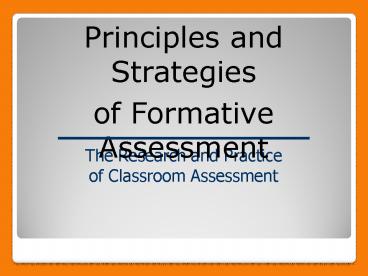Principles and Strategies of Formative Assessment - PowerPoint PPT Presentation
1 / 12
Title:
Principles and Strategies of Formative Assessment
Description:
Highlight important ideas that support formative assessment practices for student learning. ... assessment information to revise and guide teaching and learning. ... – PowerPoint PPT presentation
Number of Views:47
Avg rating:3.0/5.0
Title: Principles and Strategies of Formative Assessment
1
Principles and Strategies of Formative Assessment
The Research and Practice of Classroom Assessment
2
- Learning Objectives
- What is Formative Assessment?
- Does research support formative assessment
practices? - What is needed to support formative assessment
practices? - What are formative assessment classroom
strategies ?
3
- Crucial Distinction
- Assessment OF Learning (Summative)
- How much have students learned as of
- a particular point in time?
- Assessment FOR Learning (Formative)
- How can we use assessment to help students learn
more?
4
Inside the Black BoxRead pgs. 10
16 Highlight important ideas that support
formative assessment practices for student
learning.
5
Rivals one-on-one tutorial instruction
Largest gains for low achievers
- Research on Effects
- Study S.D. Gains
- Bloom (1984) 1.0 to 2.0
- Black and Wiliam (1998) .5 to 1.0
- Meisels, et al. (2003) .7 to 1.5
- Rodriguez (2004) .5 to 1.8
6
35 Percentile Points 2-4 Grade Equivalents
100 SAT Score Points 5 ACT Composite Score
Points U.S. TIMSS scores move from the
middle of the pack to top 5
- 1.0 Standard Deviation Score Gain Equals
7
Inside the Black Box
- Triad discussion using quotes from the article
Inside the Black Box. - Read all quotes.
- As a group, choose one quote. Reflect on the
meaning of the quote and the implications for
teaching and student learning.
8
Our Assessment Future Comparing Assessment of
and for Learning R. Stiggins video clip
Assessment for Learning Assessment of Learning
Distinction between Assessment systems
Focus of assessment on State Standard
Teachers Role
Students Role
Student motivation
9
What are the Big Ideas of Formative Assessment
Practices?
- Table Discussion
- As a table, discuss the big ideas about formative
assessment practices based on your notes from the
article and video clip. Choose one big idea
about formative assessment practices to share
with the whole group. - Whole Group Discussion
- Chart Big Ideas
10
Alignment of the Principles of Formative
Assessments to the Learning Team Continuum of
Work for Mathematics
Nine Principles of Assessment for Learning
Principles of Assessment for Learning (1) Teachers understand and can articulate in advance of teaching the achievement targets students are to hit. (2) Students are informed daily about the targets in terms they can understand (i.e., student-friendly language) and which clarify what they are expected to learn. Students study the criteria by which their work will be evaluated by analyzing samples of strong and weak work. (3) Students can describe what targets they are to hit. Teachers can describe what comes next in student learning. (4) Classroom teachers transform those targets into assessments that yield accurate information about student learning of the content. (5) Teachers use classroom assessment information to revise and guide teaching and learning. Students use assessment information in ways that require them to think about their own progress. (6) Feedback given to a student is descriptive, frequent, and timely. Feedback provides insight on a current strength and focuses on one facet for revision linked directly to the intended learning. (7) Students actively and regularly practice using descriptive feedback to improve the quality of their work. Students develop skills of self-assessment to monitor their learning. (8) Students keep track of their own learning over time (e.g., journals, portfolios) and communicate with others (e.g., students, teachers, parents) about what they understand and what they need to understand better. (9) Teachers understand the relation between assessment and student motivation and use assessment to build student success and confidence rather than failure and defeat.
Learning Team Continuum Stage 1 Learning Targets Stage 2 Align State Framework and Math Program Stage 3 Common CABS Stage 4 Student Work on CABS Stage 5 Descriptive Feedback on CABS
Learning Team Continuum Understand importance of identifying and articulating big ideas in mathematics to bring consistency to a schools math program. Develop meaning for the math embedded in the targets and alignment to state standards and descriptors and to the schools math program. Provide a measure of consistency of student learning based on standards/descriptors and targets. Examine student work to monitor achievement and progress toward the targets and descriptors. Use student work to inform instructional decisions, and to provide students with appropriate descriptive feedback.
11
Alignment of the Principles of Formative
Assessment to the Learning Team Continuum of Work
for Mathematics
- How will you use this resource in your work as a
Math Teacher Leader?
12
- Learning Objectives
- What is Formative Assessment?
- Does research support formative assessment
practices? - What is needed to support formative assessment
practices? - What are formative assessment classroom
strategies ?































